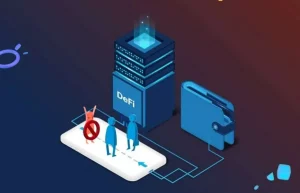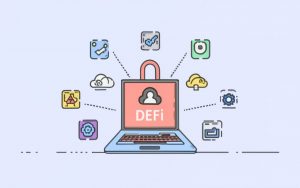An Easy Way to Create Your Own DeFi Token

DeFi is a relatively new, revolutionary finance concept and, so far, seems like more than a decent alternative to traditional finance systems. It is tightly related to common financial services, such as lending, however, this time, states, central banks, and directors are entirely ruled out of the context.
DeFi tokens are the flesh and blood of decentralized platforms, and they massively contribute to DeFi development and popularity. They are also given specific utilities and values, and the entire system would be practically void if it wasn’t for them.
Some of these utilities include higher interest rates and trading discounts. Now that we’ve made a mini digression on what is a DeFi token, let’s talk more about how to create your own DeFi token.
How to Create a DeFi Token?
Before moving on to the heart of the matter, let’s just clarify something first. There’s no point in launching a DeFi token if the token itself has no value and utility. There are already too many DeFi protocols and tokens out there that lack vision.
For a token to be in demand, there should be a strong financial service behind it such as asset management, insurance, or something not yet seen in the DeFi world, something that solves a pain point, something people are strongly dissatisfied within the real-world (f.e. excessive bureaucracy or big banking data leaks). As an example, there are DeFi tokens that make lending protocols, DeFi exchanges, and advertising platforms fully functional.
Ideally, you have already built a financial instrument of some kind, customer demand is fair-to-middling, and now, you want to expand it and launch a token. Luckily, it is a no-sweat, pretty straightforward, and affordable process.
Here’s how to make a DeFi token.
1. Tokenomics
First of all, you should come up with the token name and logo, and then give some thought to tokenomics or token economics. Crypto investors tend to judge a token’s value by several factors, one of which is total supply. Fixed, lower supply can, potentially, create scarcity, increase demand and push the price up. A lot depends on your token distribution strategy as well. Keep in mind that you should reserve some of the tokens for your team.
The second factor is – how the token will be used. Clarify whether the token will have a unique utility pegged to the financial service or platform you are building or have already built. If so, what kinds of benefits will it provide to users? Do you want to integrate it with, let’s say, voting, loyalty program, or crowdfunding? Do you have staking on your mind? You should make it clear whether your service/platform’s increased usage will affect the token’s price in a positive manner (preferably, it will).
Or, you can decide to create a governance token. As you can already guess, holders this way receive the right to vote, propose, and participate in the decision-making process. The more tokens you hold, the greater voting power you have, while the ones that have fewer tokens get less power. The team behind the project assumes that true believers in their project would heavily invest in the token and propose the things or vote on proposals that will help the project achieve success.
Uniswap (UNI) is among the most popular governance DeFi coins that announced the governance token wave. MKR (Maker) and CAKE (PancakeSwap) are among well-known governance tokens. Nowadays, more and more projects encourage early adopters to participate in voting actively. Oddly, token holders can vote that the token itself can’t be traded until they decide so.
SafeMoon is worth taking a look at, since it is a perfect example of the awesome utilities one DeFi token can introduce. It was launched in 2021 and rapidly gained momentum despite being a newcomer to the crypto industry. This is a community-driven token that features manual burning (this reduces the supply, increases demand, and enhances token utilization), automated market making, RFI static rewards, and an automated liquidity pool just to name a few.
All of this (technical details, financial data, holders’ benefits, and terms and conditions) should be thoroughly explained in the project’s whitepaper. A whitepaper can help you make it or break it, depending on whether you get potential investors hooked on the idea behind your project/token.
2. Network
You can choose between several blockchain networks to launch your DeFi token on. The Ethereum network is the most obvious option here, although you can opt for Binance Smart Chain or Tron since all of these provide much the same services.
ERC20 and ERC721 and the two popular Ethereum tokens. The latter, ERC721, is immensely used in the NFT world, and DeFi utility tokens such as $SUPER or $WHALE are already a thing. Now that we’ve mentioned NFTs, many not so long ago launched projects that introduced their utility tokens. Staking an NFT gives you a set amount of tokens per day while tokens are then used for buying merch, obtaining whitelist spots, entering raffles, etc.
And then, you can also create a DeFi token on Binance Smart Chain (BEP-20 is its technical specification). BSC makes it easy for developers to launch a variety of tokens compatible with their ecosystem that can represent financial assets, lottery tickets, skills or upgrades of in-game characters, and fiat currency. SafeMoon, which we have mentioned in the previous section, is one of the most talked-about DeFi coins built on BSC.
Although this is a whole other story, we just want to mention that stablecoins are DeFi tokens as well. As their name says, these tokens are developed to, unlike most cryptocurrencies, provide stability, resist volatility and manipulation, and are pegged to fiat currencies such as USD.
3. Smart Contract Launch
Now, it’s time for the technical side of the process, and that is – launching a smart contract. If you’re not a DeFi dev, then hire someone who has skills in this field and a proven track record or a blockchain development company. Once the smart contract is launched, make sure that the token can be transferred to other addresses with no bother and decide upon transaction fees.
Note that transaction fees for POW (Proof-of-Work) tokens are pricier since miners use expensive equipment to verify transactions. On the other hand, POS (Proof-of-Stake) tokens feature relatively lower fees. Not so long ago, ETH switched from POW to the POS ecosystem, which contributed to increased optimism around it. Self-evidently, your transaction fees also depend on the blockchain network you choose for your token launch.
If you opt for higher fees, you’ll probably drive away retail traders since high fees signalize lower market activities and reduce confidence about investing in a certain token.
Integrate a multi-token wallet and transfer the tokens from the original wallet to another one to make sure they are securely stored. The token migration process should be easy and smooth. Other DeFi wallets should be notified each and every time a token transaction occurs.

DeFi tokens should be stored in a non-custodial wallet upon creation to make sure no one, besides the ones with the seed phrase, can access the funds.
Image Source: Instagram
Finally, try sending some tokens to another user. If you can see transaction details such as hash, block number, and the amount of tokens sent, that means you’ve done everything right and your token is fully ready to use.
4. Integration With Other Financial Services and Marketing
If you want to make users more enthusiastic about your DeFi token, integrate it with other financial services – payment gateways, service providers, DeFi exchanges (DeFi Swap, Curve, PancakeSwap) and wallets (Metamask, Trust Wallet, Trezor), and maybe even banks, which will give it more publicity. Ideally, you’ll want to upgrade your DeFi token with features such as pooling, staking, and liquidity management as well.
You can also leverage the power of social media, marketing tools, and advertising platforms to make the token even more visible to worldwide traders
5. Cold Storage
Store your DeFi tokens in a cold storage facility. This will prevent hacker attacks and any other kind of unauthorized access and instill trust among users that their tokens will remain safe and sound. You can also try a multisignature wallet to protect your token from insider attacks and rug pulls. In order to create a secure environment for everyone invested in your project, we highly recommend using an escrow service as well.
6. Customer Support
Now that everything is up and running and your token is brought to the fore, you should also provide top-notch customer service and support. Users will probably raise some queries or report glitches, and you should cultivate relationships with loyal customers. On the other hand, this will help you reduce customer acquisition costs and make your project even more valuable in the eyes of potential investors.
So, that was all about how to create and launch a DeFi token successfully but let’s go through some of the related questions you may have.
How Much Does It Costs to Make a DeFi Token?
It all depends on where you live and whether you are doing it all by yourself or using someone else’s services. You are going to need more than $8,000 for wallet development and more than $1750 for smart contract development if you want to hire a professional to take care of the token launch.
What’s The Difference Between a DeFi Coin and DeFi Token?
Phrases DeFi coins and DeFi tokens are used synonymously, although the first ones stand for native tokens while the second ones are built on the same blockchains as native tokens but have different, most often, snazzier utilities.
Image Source: Instagram
So, do you want to launch a DeFi coin or token, or you can use these phrases interchangeably? Although most people actually think there’s no difference between a coin and a token, the difference between the two is quite significant.
A coin is a synonym for a blockchain’s native asset or currency. As an example, Ethereum is a native token to the Ethereum blockchain. Performing transactions on the blockchain requires users to pay transaction fees in Ethereum.
And then, there are thousands of tokens built on the same blockchain but have their own utilities, typically different from the utilities native coins feature such as crypto lending and borrowing, yield farming, etc. This also makes DeFi tokens more flexible compared to coins that are, except for ETH, mainly used for payments. Yet, keep in mind that DeFi tokens, unlike DeFi coins, don’t necessarily transfer value in a financial sense.
DeFi Tokens and Common Risks
If someone buys your tokens, no matter if it is directly or through an exchange (centralized or decentralized), they can be exposed to some of the risks associated with DeFi protocols. That means that DeFi protocols can experience critical vulnerabilities. Last year, hackers exploited a fault in Compound’s code, drained millions of dollars from their wallet, which made their token’s price sink back.
On the other hand, DeFi tokens are sensitive to market sentiment, manipulation, and other factors that can affect coins as well. Someone from the team leaving, details about involvement in unethical activities (frauds, rug pulls, etc), and congested transactions can also make the token fall sharply.
Summary
Although we’re still in an early phase of DeFi, it’s safe to say that the demand for DeFi tokens will blow up before too long. Now you know how to create your own DeFi token in an easy way, nothing is stopping you from making a move since this will help your project gain heavy business traction. Alternatively, you can hire a token development agency to handle the entire process while you are going to reap all of the DeFi world benefits shortly after the token is actually developed.
Javier Niskanen is a crypto investor who is passionate about helping others achieve success. He has a background in computer science and has been involved in the crypto world since early 2017. Javier is excited to see how blockchain technology will change the world for the better.









